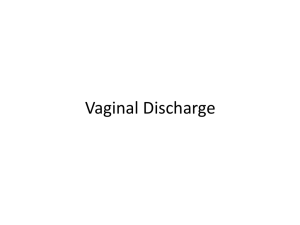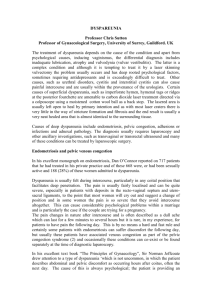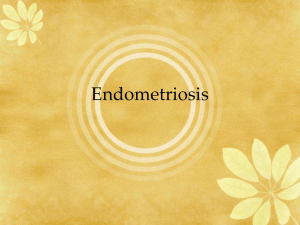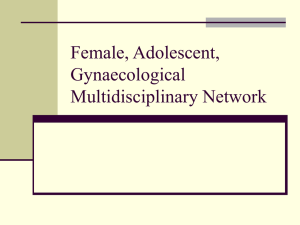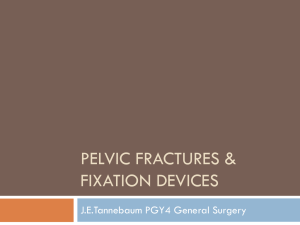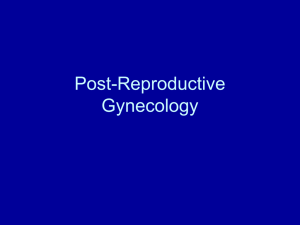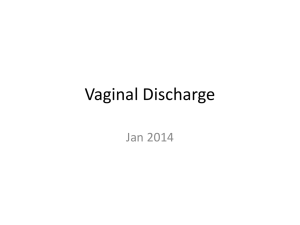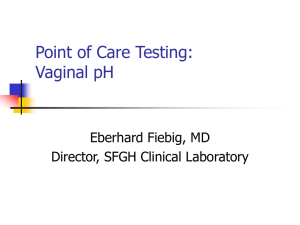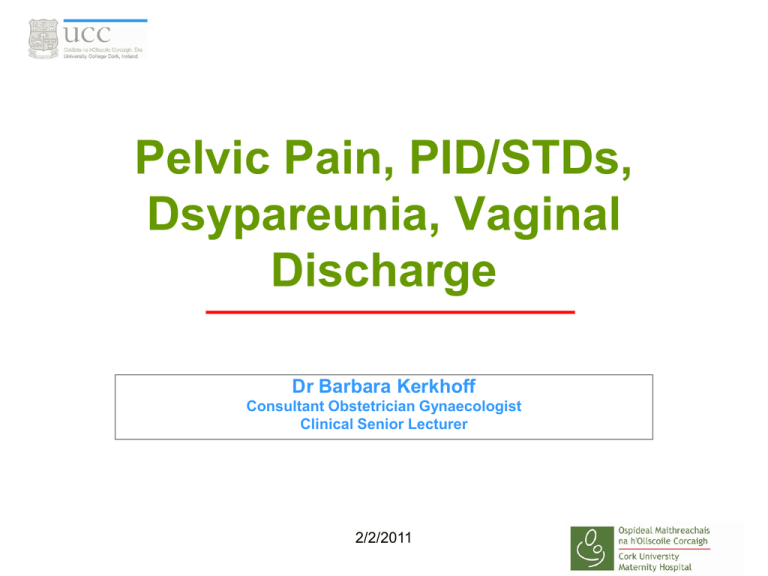
Pelvic Pain, PID/STDs,
Dsypareunia, Vaginal
Discharge
Dr Barbara Kerkhoff
Consultant Obstetrician Gynaecologist
Clinical Senior Lecturer
2/2/2011
Lecture plan
• Chronic/ acute pelvic pain
– Endometriosis
•
•
•
•
Pelvic inflammatory disease
STDs
Vaginal discharge
Dyspareunia
2/2/2011
Pelvic pain
Acute pain
intense and characterized by the sudden onset,
sharp rise, and short course.
Chronic pelvic pain
Pain of > 6 month in duration with at least 2
weeks duration/ month
Localized to the anatomical pelvis
Severe enough to cause functional disability
or necessitating medical care
2/2/2011
Chronic Pelvic Pain
• Prevalence: 38/1,000 in primary care
populations (asthma is 37/1,000)
• Women > men
• Misdiagnosis or lack of diagnosis is common
• Accounts for 10% of referrals to gynaecologists
• 40% of laparoscopies performed by
gynecologists are for chronic pain
• Only 50% of patients actually receive a
diagnosis, 20% never had any investigations
• 34% have had at least
one diagnostic procedure
2/2/2011
What Contributes to CPP
•
•
•
•
•
•
•
Visceral sources
Uterus, fallopian tubes, ovaries
Bladder, GI tract, Peritoneum
Blood vessels
Muscles of pelvic floor and abdominal wall
Bone
Neuropathic sources
– Central and peripheral nerves
– Sympathetic nerves
2/2/2011
What Contributes to CPP
•
•
•
•
Psychosocial phenomenon
Secondary gain
Previous therapies/iatrogenic causes
Multiple surgeries
– Adhesions, Distorted anatomy, Nerve
compression, Nerve injury
• Fibromyalgia
• Lower back - spinal cord
2/2/2011
• Medication/treatment
history
Other Risk Factors
•
•
•
•
•
•
•
•
Poor posture
Sedentary lifestyle
Muscle trauma
Post delivery
Obesity
Sexual abuse
Local and referred pain
May be a primary disorder or occur secondary to
other visceral or somatic pathology
2/2/2011
Common Diseases in CPP
•
•
•
•
•
•
•
•
•
•
•
Endometriosis
Adenomyosis
Interstitial cystitis
Myofascial pain syndrome
Irritable bowel syndrome
Adhaesions
Pelvic congestion syndrome
Pudendal neuralgia
Post herpetic neuralgia
Vulvodynia
Vaginismus/ Dyspareunia2/2/2011
Pelvic pain
Non-Gynaecologic Origin
• Gastrointestinal
– Appendicitis or appendiceal abcess
– Inflammatory bowel disease
• Urinary Tract
– Acute cystitis or pyelonephritis
– Ureteral lithiasis
• Orthopaedic
–Lumbo-sacral muscle spasm
–Lumbar disc disease
2/2/2011
Pelvic pain - gynaecological
•
•
•
•
•
•
•
•
Endometriosis
PID
Mass - e.g fibroid, ovarian mass
Trapped ovary
Adhaesions
Psychological
Chronic UTI
(Constipation / IBS)
2/2/2011
Therapy for CPP
•
•
•
•
Physical therapy
Psychological evaluation and support,
stress management
Maximizing co-morbid pathology
– Depression, low back pain, obesity, diarrhea, constipation
•
Medications
–
–
–
–
–
Hormones (OCP, progesterone, GnRH angonists)
Muscle relaxants and other agents
Adjunctive medications
Analgesics
Disease specific medications
• Injection therapy (Trigger Point injections Nerve blocks)
• Surgery
2/2/2011
Summary
•
•
•
•
•
CPP is a complex pain syndrome
Many contributing factors
Myofascial contributors frequently over looked
Pelvic floor “forgotten” myofascial source
Integrated approach offers best chance at best
outcomes
• Evaluate pain behaviors
• Return to functioning is a more realistic goal
than making a patient pain free
• Correct predisposing factors
2/2/2011
Acute pelvic pain
Causes
• Endometriosis
– Flare of endometriosis
• Adnexal accidents
– Ovarian torsion, hemorrhage, rupture
– Ovulation (Mittelschmerz)
• Ruptured ectopic pregnancy
• Endometritis
• PID, STDs
2/2/2011
Endometriosis
Definition
• The presence of functioning endometrium cells
outside the uterine cavity
5 - 10% of all women
Aetiology
• Retrograde menstruation,
coelomic metaplasia, blood borne,
immunological
Where
• Anywhere!
• Ovaries and uterosacral ligaments
2/2/2011
Endoscopic
image of
endometriotic
lesions at the
peritoneum of
the pelvic wall.
2/2/2011
Endometriotic lesions in the Pouch of Douglas
and on the right sacrouterine ligament
2/2/2011
Symptoms
• Acute and chronic pain,
• Dysmenorrhoea,
• Dyspareunia,
• Dyschezia
• Dysuria
• Infertility
Signs
• Tenderness, cervical excitation, endometrioma
2/2/2011
Endometrioma
2/2/2011
2/2/2011
2/2/2011
Endometriosis
Diagnosis
• Biopsy
• Laparoscopy
Treatment
• Do nothing / simple analgesia/ anti inflammatories
• Hormonal – COCP, Progestogens, Implanon,Depot
Provera, IUCD, danazol)
• GnRH analogues
• Surgical – ablation/excision
• Hysterectomy +/- BSO
2/2/2011
Ovarian Cysts
• Follicular, Corpus
luteum Cyst
• Dermoid cysts
• Cystadenomas
• Endometrioma
• PCOS
2/2/2011
Adnexal torsion
•
•
•
•
•
•
Physical findings
–50% nausea, vomiting
–43% ▲WBC
–34% peritoneal signs
–20% fever
Pain often intense
initially, then improves
with ischemia and loss
of nerve transmission
• Exam: unilateral tender
adnexal mass
2/2/2011
Pelvic Inflammatory Disease
• Inflammation of upper genital tract and
surrounding structures
• Endometritis, salpingitis,
• Tuboovarian abcess,
• Peritonitis,
• Perihepatitis (Fitz-Hugh-Curtis)
2/2/2011
Perihepatitis (Fitz-Hugh-Curtis)
2/2/2011
Pelvic Inflammatory Disease
Causation
• Often polymicrobila infection
• Chlamydia trachomatis, Neisseria gonorrhoea
• Anaerobes and aerobes of normal vaginal flora
• NOT NECESSARILY STD
Risk factors
• Multiple sexual partners
• Lack of condom/contraception use
• Drugs alcohol
2/2/2011
Pelvic Inflammatory Disease
The most common etiologic agents in PID are:
•
•
•
•
•
•
•
Neisseria gonorrhoeae,
Chlamydia trachomatis
Anaerobic bacterial species found in the vagina,
particularly Bacteroides spp.,
Anaerobic gram-positive cocci, (Peptostreptococci),
E. coli
Mycoplasma hominis
2/2/2011
Pelvic Inflammatory Disease
Symptoms
• Lower abdo pain, mild to severe
• Vaginal discharge, Dysuria
• Prolonged menstrual bleeding
• Dysmenorrhoea / dyspareunia
• Symptoms may persist despite treatment ?chronic infection
or scarring of organs
Signs
• Abdo tenderness, cervical excitation
• Cervical muco-purulent discharge
• ↑temp ↑WBC ↑ESR ↑CRP may be normal if Chronic PID
2/2/2011
Pelvic Inflammatory Disease
Diagnosis
• Swab vaginal, endocervical, peritoneal
• Ultrasound/ MRI
• Laparoscopy/ Laparotomy
• May need admission
2/2/2011
Laparoscopic findings – Acute PID
Pyosalphinx
2/2/2011
Treatment
• Antibiotics
• Surgical
Long term problems
• Chronic pelvic pain
• Ectopic (12 - 50%)
• Infertility (6 to 10 fold increase)
2/2/2011
Prevention
• Risk reduction
– Barrier methods, condoms
– Avoiding vaginal activity after end of
pregnancy or surgical procedures (cx closed)
• Education
– Early treatment, STD screening
• Treatment of partner
2/2/2011
Dyspareunia
Pain during intercourse
• Primary
• Secondary
• Superficial
• Deep
2/2/2011
Dyspareunia - causes
• Vulval – infection, trauma, skin
condition
• Vaginal – infection, vaginismus, xerosis
• Cervical – PID, endometriosis (tumour)
• Pelvic – PID, endometriosis
• Anatomical
• Non- gynae
• Psychological
2/2/2011
Management
• Take carefully history
• Careful examination of pelvis to identify
site and source
• Remove the source of pain
2/2/2011
Dyspareunia
• Vaginismus - spasm of vaginal muscles
– Fear and pain of penetration
– Gynaecological surgery
– Radiation in oncology
– After childbirth
2/2/2011
Treatment
• Superficial
dyspareunia
• Vaginal dilators
• Local infection
• Corrective surgery
2/2/2011
Treatment
• Deep dyspareunia
– Treat causes
– Endometriosis
– PID
– STDs
Vaginal discharge
• Most common gynae complaint in primary
care
• Take full history – colour, consistency,
duration, STD’s, contraception, odour
• Examination – systemic and local
• Vaginal and endocervical swabs
2/2/2011
Vaginal discharge - causes
•
•
•
•
•
•
•
Physiological – often cyclical
Bacterial Vaginosis
Trichomas Vaginalis
Candidiasis
Gonorrhoea / Chlamydia
Atrophic vaginitis
Rare causes – malignancy
2/2/2011
Bacterial vaginosis
• Prevalence of 12%
• May occur and resolve
with menstrual cycle
• Not necessarily sexually transmitted
• Change in bacterial flora (anaerobs)
• Gardnerella vaginalis, Bacteroides spp,
Mobiluncus spp, Mycoplasma spp
• Resulting rise in vaginal pH
2/2/2011
Bacterial vaginosis
Diagnosis by Amsel criteria
• Vaginal ph > 4.5
• Release of fishy smell with KOH
• Characteristic discharge
• Clue cells on microscopy
Treatment
• Metranidazole – oral or topical
2/2/2011
Trichomonas
• Flagellated protozoan
• STI
• Irritation and soreness
of vulva, perineum
• Dyspareunia, dysuria
• Strawberry cervix
• Treat with metronidazole
2/2/2011
Candidasis
• Affects 33% of women, many
asymptomatic
• Colonisation to infection
• Risk factors – antibiotics, COCP,
pregnancy, immunosuppression
• Only treat if symptomatic
• Can be difficult to treat
if chronic
2/2/2011
Candidasis
• Pruritis, white/yellow
discharge, thick
• No odour / yeasty
• Hyperaemic vagina
Treatment
• Intravaginal imidazoles
• and tiazoles
• Fluconazole oral 2/2/2011
Chlamydia trachomatis
• Common genital & eye disease
• most common sexually transmitted
infections worldwide
• 50 - 70% asymptomatic
• Dyspareunia, discharge, dysuria,
• PID, mucopurulent cervicitis
• Male sterility, female infertility
• Azithromycin, Doxycycline, erythromycin
2/2/2011
Vaginal discharge – differential diagnosis
Symptoms and
signs
Candidiasis
Bacterial
vaginosis
Trichomonus
Cervicitis
Itching &
soreness
++
-
+++
-
Smell
Yeasty
Fishy
Offensive
nil
Colour
White
White/yellow
Yellow/green
Clear
Consistency
Curdy
Thin
Thin
Mucoid
pH
<4.5
4.5-7.0
4.5-7.0
<4.5
Diagnosis
Micro and
culture
Microscopy
Micro and
culture
Chlamydia &
Gonorrhoea
2/2/2011
STDs or STIs
• Person may be infected, may potentially
infect others, without showing signs of
disease (STIs)
• Mainly via vaginal intercourse, oral or anal
sex
• Transmitted via iv drug needle
• Childbirth
• Breastfeeding
2/2/2011
STIs
• Incidence
– WHO 1999, 340 million new infection,
excluding HIV
• Causes
– Bacterial
– fungal
– Viral
– Paracites
– Protozoal
Sexual transmitted disease
From 60 - > 1000/ 100.000 inhabitants,
excluding HIV, 2004 WHO
• Incidence
– WHO 1999 1 million new infection a day
• 60% < 25yrs, of those 30% < 20yrs
• American propaganda
poster targeted at
World War II soldiers
and sailors appealed
to their patriotism in
urging them to protect
themselves from VDs.
2/2/2011
Bacterial
• Bacterial Vaginosis (BV)
– not officially an STD but affected by sexual activity.
• Chancroid (Haemophilus ducreyi)
– Genital ulceration, soreness
• Granuloma inguinale
– Painless genitals ulcers
•
•
•
•
Gonorrhea (Neisseria gonorrhoeae)
Lymphogranuloma venereum
Chlamydia trachomatis
Syphilis (Treponema pallidum)
2/2/2011
Haemophilius ducreyi
Gonorrhea
• Men:
– yellow discharge, dysuria &
freuquency
– infertility
• Women: 50% asymptomatic
– Discharge, abdominal
discomfort, dysuria, abnormal
bleeding
Penicillin revolutionized the treatment
– PID
of venereal disease, 1944
– infertility
2/2/2011
Bacterial
• Bacterial Vaginosis (BV)
– not officially an STD but affected by sexual activity.
• Chancroid (Haemophilus ducreyi)
– Genital ulceration, soreness
• Granuloma inguinale
– Painless genitals ulcers
• Gonorrhea (Neisseria gonorrhoeae)
• Lymphogranuloma inguinale (Chlamydia trachomatis)
– Infection of lymph nodes, Genital ulcers, abscess in groin
• Chlamydia trachomatis
• Syphilis (Treponema pallidum)
2/2/2011
Haemophilius ducreyi
Syphilis
• Primary
– Prim. Chancre at site
of infection
• Secondary
– Rash on palm & hands
– Fever, weight loss. malaise
• Tertiary
– Gummas (granulomas),
neurological changes etc
Penicillin, Tetracyclin
Albrecht Dürer
2/2/2011
Viral
• Hepatitis B virus - saliva, venereal fluids
• Herpes Simplex (Virus1, 2) - skin and mucosal,
transmissible with or without visible blisters
• HIV/ AIDS (Human Immunodeficiency Virus) venereal fluids
• Genital warts ("low risk" types of Human
papillomavirus HPV) - skin and muscosal,
transmissible with or without visible warts
• Molluscum contagiosum – close contact
– Not painful, may itch
2/2/2011
• Fungal
– Yeast infection
• Parasites
– Scabies, crab louse
• Protozoal
– Trichomoniasis
Sarcoptes scabiei
2/2/2011
Pubic lice
Prevention
• Incurable disease (HIV, Herpes)
• Education
– Condom use
• Vaccines
– Hepatitis A & B, HPV,
Summary
• Dyspareunia – superficial, deep
- infective, inflammatory, ‘physiological’, tumour,
anatomical
• Vaginal discharge – physiological or pathological
- BV, Candidiasis, Trichomonas, PID
• PID – related to sexual activity
- Chlamydia and gonorrhoea
- BUT not necessarily an STI
- pain, occasional vaginal discharge
- can be acute or chronic
- associated with infertility, ectopic
• Chronic pelvic pain – PID, endometriosis, tumour,
trapped ovarian syndrome, unknown
2/2/2011
Summary
• Infection are common
• Can cause infertility
Education & Prevention!!!!
www.cdc.gov - Sexually Transmitted Diseases
Treatment Guidelines, 2010
2/2/2011

